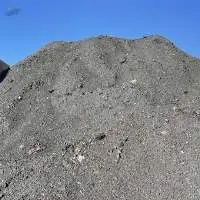
We are glad to propose 500 MT of stain less steel mill scale. Mill scale is formed on the outer surfaces during by the hot rolling lamination of stainless-steel products. At a visual inspection the material is a hard brittle sand and is mainly composed of iron oxides, mostly ferric, and is bluish black in colour, but it also contains considerable alloying elements such as chromium and nickel. The recovery ratio after melting in furnace for the most valuable alloy elements is: - Ni: 3.5 - 4.5% - Cr: 6-8% From the chemical and physical analysis performed on the scrap, and according to the European environmental rules, the material has been classified as a special non dangerous waste, listed in green list. In particular the mill scale can be classified as follows: Waste code: 10 02 10 The material is stored on cemented flooring, and it can be loaded loose in tipper trucks or containers. Chemical analysis of the material is available on request.
We hold immense expertise in making available Copper in many forms including LME registered and non registered cathodes, billets, rods, cakes, bars, foil, sheet, granules, plates, powder, shot, turnings, wire, insulated wire, mesh and “evaporation slugs”. Copper is one of the most important metals. Copper is reddish with a bright metallic lustre. It is malleable, ductile, and a good conductor of heat and electricity (second only to silver in electrical conductivity). Its alloys, brass and bronze, are very important. Monel and gun metals also contain copper. The most important compounds are the oxide and the sulphate, (blue vitriol
We put forward a high quality of assortment of Nickel which is available in many forms including LME registered and non registered cathodes, cut cathodes, briquettes, pellets, disks, shots, granules, foil, powder, flakes, sheet, wire, mesh, spheres, “evaporation slugs”, and rods. Nickel is a silvery white metal that takes on a high polish. It is hard, malleable, ductile, somewhat ferromagnetic, and a fair conductor of heat and electricity
We offer a wide plethora of Zinc in many forms including LME registered and non registered Special High Grade Ingots and Jumbos, cathodes, dust, foil, granules, powder, pieces, anodize activated powder, shot, and a mossy form. Zinc is a bluish-white, lustrous metal. It is brittle at ambient temperatures but is malleable at 100 to 150°C. It is a reasonable conductor of electricity, and burns in air at high red heat with evolution of white clouds of the oxide. Plating thin layers of zinc on to iron or steel is known as galvanizing and helps to protect the iron from corrosion.
Supplier: Salt and salt chemicals, sodium chloride (salt), sodium sulphate, sodium sulfite, sodium bisulfite, sodium carbonate (soda ash), sodium metabisulphite
Supplier: Iron oxide, zinc product, aluminum, rutile, ilmenite, struverite, monazite, etc
Buyer: Metal ores, zircon sand
Commodity: Sodium Sulphate anhydrous Product Nature Molecular formula: Na2SO4 Molecular weight: 142.04 Property: white granular crystal or powder Use As filler of detergent, the making of sodium sulphide, water glass, or used in papermaking, glass, dye and used as filler, dyeing auxiliary, laxative, antidote, t also can be used in fiber, leather, metallurgy, enamel and soap. Specifications Item GB6009-2003 Type First grade Result of common product Result of neutral product Na2SO4 99.0 99.20 99 40 Water insoluble matter %0.05 0.02 03 Ca & Mg %(Mg) 0.15 0.02 02 Chloride %(Cl) 0.35 0.23 20 (Fe) 0.002 0.0001 0001 Moisture % 0.20 0.02 02 Whiteness % 82 88 85 Packing and Storage Knitted bags lined polyethylene plastic bags double packaging, Weighing 25Kg/50KG/1000Kg. Transportation-and harsh rain. Stored in a cool, ventilated, dry place.
The primary use of Ammonium Sulphate is as a fertilizer for alkaline soils. In the soil the ammonium ion is released and forms a small amount of acid, lowering the pH balance of the soil, while contributing essential nitrogen for plant growth. The main disadvantage to the use of Ammonium Sulphate is its low nitrogen content relative to Ammonium Nitrate, which elevates transportation costs. It is also used as an agricultural spray adjuvant for water soluble insecticides, herbicides, and fungicides. There it functions to bind iron and calcium cations that are present in both well water and plant cells. It is particularly effective as an adjuvant for 2,4-D (amine), glyphosate and glufosinate herbicides.
S.N CAS No. Item 1 100-21-0 Terephthalic acid 2 67763-03-5 Silsesquioxanes 3 9003-01-4 Acrylic acid 4 1333-86-4 Carbon black 5 80-62-6 Methyl methacrylate 6 61788-97-4 Haloperidol 7 75-38-7 1,1-difluoroethylene 8 100-42-5 Styrene 9 9002-84-0 Poly(tetrafluoroethylene) 10 124-04-9 Adipic acid 11 107-21-1 Ethylene glycol 12 126-30-7 Neopentyl glycol 13 85-44-9 Phthalic anhydride 14 106-89-8 Epichlorohydrin 15 9003-08-1 Amino resin 16 9006-03-5 Chlorinated rubber 17 13463-67-7 Titanium dioxide 18 12227-89-3 Iron Oxide Black 19 922-67-8 Methylpropiolate 20 538-24-9 Trilaurin 21 9011-05-6 Urea formaldehyde 22 79-41-4 Methacrylic acid 23 1314-13-2 Zinc oxide 24 80-05-7 Bisphenol A 25 121-91-5 Isophthalic acid






